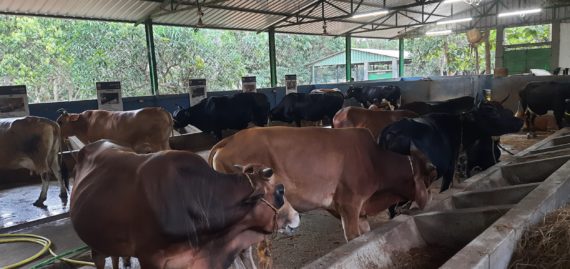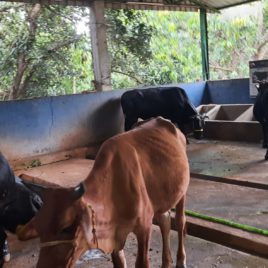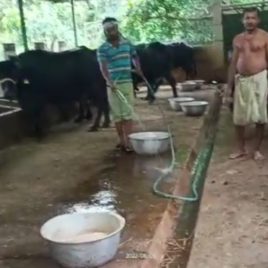This is a skill-oriented course to provide hands-on practice and project work in dairy farming. They will learn day to day economic characteristics about farm management, disease management, feeding management, identification of different breeds, clean milk production and cattle and buffaloes.
Dairy Farming
Dairy Farming
Course Attendees
Still no participant
Course Reviews
Still no reviews
Code(Credit) : ABC01(0-4-0)
| Scheme | Innovation Agriculture Project, NSDC |
| NSQF Level | 5 |
| Duration | 3 Months |
| Sector | Agriculture |
| Occupations | Farm Management |
| Entry Qualification | 12 Pass (preferably science/ agriculture optional) |
| Minimum Age | 17 Years |
| Aligned to (QP) | NSQF - QualFile V-6 (1)- Dairy Farm Supervisor (3) |
Course Objectives:
The objectives of this subject are:
- To meet the basic and overall practical knowledge requirement of the students of various professions in the field of dairy farming for higher profitability - specific/key points of dairy farm management.
- By seeing and doing is the key to the success of an entrepreneur in the field of dairy farming - being the main focus of the course.
- To make the students of various professional well versed with the practical skill of managing dairy farm starting from the birth of a calf till it producing its records.
- To develop self-confidence among the students on the rearing of dairy animals in farm condition, including feeding, disease control, clean milk production, breeding and selection of best animals and other intervening points from own experience for higher profitability.
- To access the financial involve and return in a well-managed dairy farm.
After completing this program-
- This skill course on dairy farming shall make the professional farmer self-sustained and practically well versed as well as shall create self-confidence to go for entrepreneurship on dairy farming.
- This course dealing with various stages of practical experience shall make the students to rectify them from doing uneconomical practices on the farm.
- The students are being involved in the farm management from day one of a calf born until it produces its performance records. The continuous process of observing & doing the typical farm management practices make students stronger in opting a self-dependent dairy farm in a large scale.
- The students shall know the behavioural attitude of farm animals from their practical experiences, which benefitted the students of various professionals for saving animals from diseases or any natural calamities.
- Can join any dairy farm and can manage independently.
- Can become an entrepreneur in the related field
Learning Record:
The trainee will submit a Practice/Project/Learning record after each class/session.
Assessment Process:
- The assessment agencies should have an expert to conduct assessment NOS wise and every trainee should score a minimum of 70% in the overall assessment.
- The assessment of the theory/knowledge will be based on a written test/viva-voce or both while the skill test shall be hands-on practical.
Course Syllabus/Contents:
All Modules
- Skills of identification of different breeds of Cattle and buffalo with respect to their production capability. Distinguished body features – udder, milk vein, teds, etc, their special care in the farms- handling and restraining of animals of different stray.
- The layout of different types of cattle shed-planning for construction for providing maximum compost to the animals, mostly the ventilation and the ground of the floor, spacing of animals etc.
- Sanitation measures of the cattle shed- for prevention of diseases, regular cleaning of the shed, process of cleaning, proper use of sanitary material (eco-friendly), maintaining dryness of the shed as well as animals etc.
- Skills of identification/ Marking of animals (cattle & buffalo) for keeping individual performance, records including treatment, protection and reproduction etc. – daily record and milk yield (daily, weekly & monthly) breeding record- date of feed, insemination and calving etc.
- Skills of knowing and observing of feed-in cattle and buffalo- monitoring of artificial insemination- technologies for conducting artificial insemination, insemination in farm research condition, identification of cattle and buffalo rise are in silent heat (most important in buffalo).
- Recording and learning of daily routine work being operated in farms- (both management and specific care of newborn calf), Skill of culturing/disposing and unproductive animals in the farm for economic return, Judging & featuring for best animals to be kept in the farm.
- Skills of computation of rations for daily animal of different stages, specifying for heifer & pregnant animal. Formulation of concentrate mixture based on low-cost technology, using locally available raw materials.
- Skills of feeding different categories of cattle- Newborn calf, heifer, pregnant animals etc.
- Skills of learning the first aid treatment in cattle and buffalo- hoof cutting, wound dressing, giving an injection, care of horn, branding, ear tagging etc.
- Skills of knowing symptoms of some common diseases- Normal physiological parameters such as temperature, pulses, offed condition, restlessness, position & movement of the stomach, defecation &urination etc.
- Skill of milking procedure- hand milking as well as machine milking, knowledge of retention of milk in the udder, letting down procedure etc.
- Common features or constituents of milk and techniques of clean milk production, its collection techniques till marketing.
List of Projects/Products/Publications :
Reference Book :
- Handbook of Dairy Farming: To Produce Milk with Packaging by Eiri Board
- The Small-Scale Dairy: The Complete Guide to Milk Production for the Home and Market by Gianaclis Caldwell.
Session Plan:
Section 1
Skills of identification of different breeds of Cattle and buffalo with respect to their production capability. Distinguished body features – udder, milk vein, teds, etc, their special care in the farms- handling and restraining of animals of different stray.
Session 1.ppt
Section 2
The layout of different types of cattle shed-planning for construction for providing maximum compost to the animals, mostly the ventilation and the ground of the floor, spacing of animals etc.
Session2.ppt
Section 3
Sanitation measures of the cattle shed- for prevention of diseases, regular cleaning of the shed, process of cleaning, proper use of sanitary material (eco-friendly), maintaining dryness of the shed as well as animals etc.
Session 3.pdf
Section 4
Skills of identification/ Marking of animals (cattle & buffalo) for keeping individual performance, records including treatment, protection and reproduction etc. – daily record and milk yield (daily, weekly & monthly) breeding record- date of feed, insemination and calving etc.
Session 4.pdf
Section 5
Skills of knowing and observing of feed-in cattle and buffalo- monitoring of artificial insemination- technologies for conducting artificial insemination, insemination in farm research condition, identification of cattle and buffalo rise are in silent heat (most important in buffalo).
Session 5.ppt
Section 6
-
Recording and learning of daily routine work being operated in farms- (both management and specific care of newborn calf), Skill of culturing/disposing and unproductive animals in a farm for economic return, Judging & featuring for best animals to be kept in the farm. Session 6.ppt
Section 7
-
Skills of computation of rations for daily animal of different stages, specifying for heifer & pregnant animal. Formulation of concentrate mixture based on low-cost technology, using locally available raw materials. Session 7.ppt
Section 8
-
Skills of feeding different categories of cattle- New born calf, heifer, pregnant animals etc. Session 8.ppt
Section 9
-
Skills of learning the first aid treatment in cattle and buffalo- hoof cutting, wound dressing, giving an injection, care of horn, branding, ear tagging etc. https://youtu.be/rDt9u9Cto7s

Section 10
-
Skills of knowing symptoms of some common diseases- Normal physiological parameters such as temperature, pulses, offed condition, restlessness, position & movement of the stomach, defecation &urination etc. Session 10.ppt
Section 11
-
Skill of milking procedure- hand milking as well as machine milking, knowledge of retention of milk in the udder, letting down procedure etc. Session 11.ppt
Section 12
-
Common features or constituents of milk and techniques of clean milk production, its collection techniques till marketing https://youtu.be/I4QGBo34VvQ

Latest News & Student Testimonials
CUTM3085 | SKILL: Layout Of Dairy Farm | CUTM
Farm Washing | Dairy Farm | CUTM






